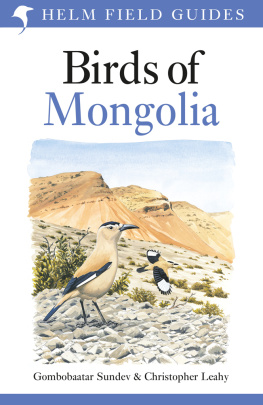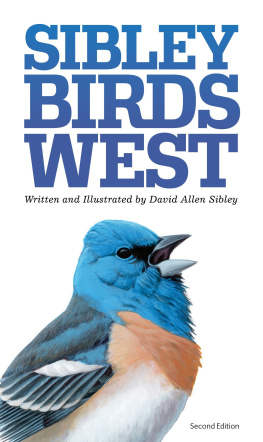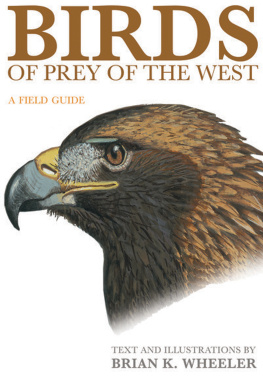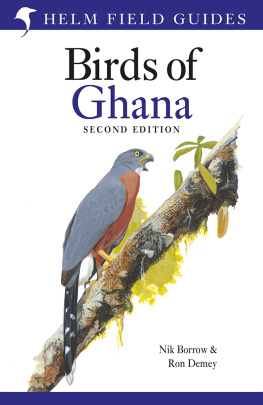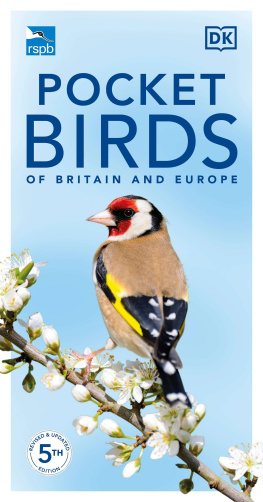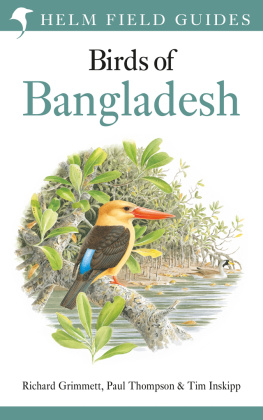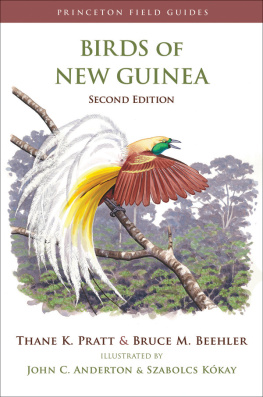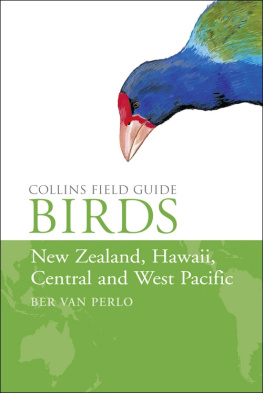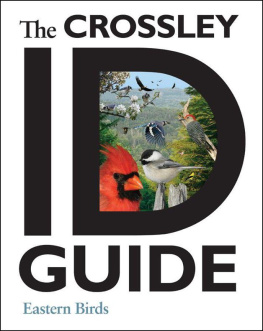Dedicated to Prof. Damdin Sumiya, Prof. Osor Shagdarsuren and Prof. Ayurzana Bold, pioneers of Mongolian ornithology, meticulous scientists, committed conservationists and honoured teachers.

HELM
Bloomsbury Publishing Plc
50 Bedford Square, London, WC1B 3DP, UK
This electronic edition published in 2019 by Bloomsbury Publishing Plc
BLOOMSBURY, HELM and the Helm logo are trademarks of Bloomsbury Publishing Plc
First published in the United Kingdom 2019
Copyright Gombobaatar Sundev and Christopher Leahy, 2019
Maps Gombobaatar Sundev and Mongolica Publishing, 2019
Front cover artwork Tim Worfolk, 2019
Back cover artwork John Gale and Dave Nurney, 2019
Plate illustrations 2019: Adam Bowley 69 (part), 80 (part); Tony Disley 64 (part), 65 (part); Carl DSilva 13 (part), 14 (part), 15 (part); Kim Franklin 22 (part), 26 (part), 27; John Gale 4447 (part); Alan Harris 4 (part), 9 (part), 10 (part), 11 (part), 13 (part), 14 (part), 15 (part), 1622 (part), 23 (part), 3031, 38, 47 (part), 52, 59 (part), 62 (part), 67 (part), 81, 91, 106; Ren Hathway 8486, 90 (part); Dave Nurney 13, 5 (part), 6 (part), 12, 2829, 3237, 3943, 5051, 53, 54 (part), 5559 (part), 6364 (part), 65 (part), 6667 (part), 6869 (part), 7072, 74 (part), 8283, 8788 (part), 8990 (part), 92 (part), 9394 (part), 95105, 107113; Christopher Schmidt 4849; Brian Small 54 (part), 62 (part), 7374 (part), 7580 (part), 88 (part), 92 (part), 94 (part); Jan Wilczur 4 (part), 5 (part), 6 (part), 79 (part), 10 (part), 11 (part); Tim Worfolk 22 (part), 23 (part), 2426 (part), 6061, 90 (part)
Topography illustrations Mike Langman, 2019
Vagrant illustrations Carl DSilva, Alan Harris and Dave Nurney, 2019
Gombobaatar Sundev and Christopher Leahy have asserted their right under the Copyright, Designs and Patents Act, 1988, to be identified as Authors of this work
All rights reserved
You may not copy, distribute, transmit, reproduce or otherwise make available this publication (or any part of it) in any form, or by any means (including without limitation electronic, digital, optical, mechanical, photocopying, printing, recording or otherwise), without the prior written permission of the publisher. Any person who does any unauthorised act in relation to this publication may be liable to criminal prosecution and civil claims for damages.
Bloomsbury Publishing Plc does not have any control over, or responsibility for, any third-party websites referred to or in this book. All internet addresses given in this book were correct at the time of going to press. The authors and publisher regret any inconvenience caused if addresses have changed or sites have ceased to exist, but can accept no responsibility for any such changes
A catalogue record for this book is available from the British Library
ISBN: 978-0-7136-8704-0 (PB)
ISBN: 978-1-4729-4949-3 (eBook)
ISBN: 978-1-4729-4948-6 (ePDF)
To find out more about our authors and their books please visit www.bloomsbury.com where you will find extracts, author interviews and details of forthcoming events, and to be the first to hear about latest releases and special offers, sign up for our newsletter.
CONTENTS
ACKNOWLEDGEMENTS
The production of this book would not have been possible without the support and commitment of family, friends, colleagues and experts on birds.
Our thanks go to Prof. Damdin Sumiya, Prof. Osor Shagdarsuren, Prof. Ayurzana Bold, Dr Shagdarsuren Boldbaatar, Dr Natsogdorj Tseveenmyadag, Axel Brunlich and Dr Mark Brazil for their recommendations; and also to Dr Sandagdorj Bayarkhuu, Dorj Usukhjargal and the Mongolian Bird Taxonomy and Rarity Committee for updating the list of bird species and providing information on vagrants. Thanks also for professional advice and recommendations from Prof. Michael Stubbe, Dr Wolf D. Busching (Germany), Prof. Reuven Yosef (Israel), Dr Anita Gamauf (Austria), Prof. Per Alstrm (Sweden), Prof. Woo Shin Lee (South Korea), Dr Kiyoaki Ozaki and Yoshimitsu Shigeta (Japan), and Rishad Naoroji (India), which were invaluable for improving the scientific and conceptual accuracy of the book.
We would like to express our thanks to the authors families, including Mrs Battsengel Munkhtuya, Kathryn Leahy and children for their encouragement, help and patience while the book was being researched and written.
The original text and early development of this book would have been impossible to start without the financial support of Tony Whitten (World Bank); Prof. Jonathan Baillie, Dr Bhattacharya B. Gitanjali and Ms Eleonor Monks (Zoological Society of London, UK); Dr Richard Reading (former Director of Conservation Biology, Denver Zoological Foundation, USA); Lynette and Ronny Mitchell (UK); Mrs Susan Sloan (USA); Dr Kate and Nigel Barton (Australia); the Mongolian Ornithological Society and Mongolica Publishing.
At Bloomsbury Publishing, we wish to thank Nigel Redman, Jim Martin and Katy Roper, Julie Dando for her considerable design talents, and Tim Harris and Marianne Taylor for their skilful editing and valuable additions to the text.
We thank all the members of the Biology Department at the National University of Mongolia and especially Prof. Mishig Tsogbadrakh, Prof. Nyam-Osor Batkhuu and Prof. Nergui Soninkhishig, head of the Biology Department of the National University of Mongolia and colleagues of the Steppe Forward Programme and Mongolian Ornithological Society for providing equipment and encouragement. We very much appreciate the help of ornithologists and colleagues at the Mongolian Academy of Sciences for their collaboration and professional recommendation, and for compiling information concerning the distribution and status of bird species. We would also like to send our thanks to members of the Mongolian Ornithological Society, including Biraazana Odkhuu, Dorj Usukhjargal, Chuluunbaatar Uuganbayar, Purevdorj Amartuvshin, Bayandonoi Gantulga, Batkhishig Oyuntuya, Dashnyam Bayanmunkh, Jamsran Munkh-Erdene and Bayarmagnai Yumjirmaa for their technical assistance in compiling maps and information on status and conservation of bird species, and providing photographs of subspecies from the Societys database.
The junior author wishes to gratefully acknowledge the support of the Massachusetts Audubon Society, especially Mr James Baird, and presidents Dr Gerard A. Bertrand and Laura Johnson for supporting the extensive field work in Mongolia undertaken through the MAS Natural History Travel Program as well as the time required to prepare the text for publication. He is also grateful to Jalsa Urubshurow, Founder and President of Nomadic Expeditions, for supporting this and other projects intended to preserve and interpret Mongolias precious natural heritage. And to his many Mongolian friends and colleagues, most especially Badral Yondon, Gereltuv Dashdoorov, Tumendelger Kumbaa, Baatarnyam Navaansharav and Ider Batbayar, with whom he has enjoyed many great adventures in all corners of this extraordinary country, his deepest thanks and affection.
PREFACE
The Mongolian people have a long tradition of resource conservation and the sustainable use of natures bounty, which was essential to their nomadic herding culture. This tradition is still seen today in Mongolians careful husbandry of their herds and selective harvesting of native plants to supply all of their basic needs for food, clothing, shelter, transportation and medicine. They were also among the first people in recorded history to practise wildlife conservation. The Italian explorer Marco Polo reported that the Mongolian emperor Khubilai Khan (121594) restricted the hunting of birds and mammals over large areas during their breeding seasons and worked to increase wildlife populations through the cultivation of food plants and the provision of natural shelter. Ancient Mongolian falconers may also have been the worlds first bird ringers, using silver bands to identify their birds.

